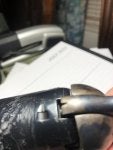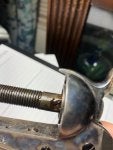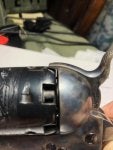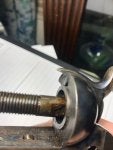I purchased a Colt 2nd generation 1851 Navy "C" model that doesn't strike the percussion caps hard enough to ignite them. The wedge is not original to the gun which may be part of the problem. I have a new one ordered from Taylor's, but I don't believe that is all the problem. When checking the distance between the dropped hammer and the back of the nipple, I noticed that the striking face of the hammer does not extend past the inner surface of the recoil shield - like it might not be reaching the cap and nipple to create ignition. The hammer won't even engage the little locking pins between the chambers.
Is this the problem? Is the hammer mis-made/defective so that the striking surface doesn't extend far enough to hit the percussion cap, or is there another cause?
I removed some of the nipples and found that at some point small washers had been placed behind the nipples in an attempt to extend them closer to the hammer.
Gun came in the early tan box.
Is this the problem? Is the hammer mis-made/defective so that the striking surface doesn't extend far enough to hit the percussion cap, or is there another cause?
I removed some of the nipples and found that at some point small washers had been placed behind the nipples in an attempt to extend them closer to the hammer.
Gun came in the early tan box.










